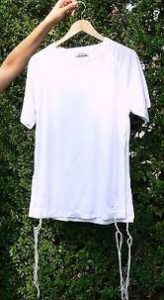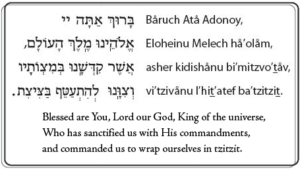A Tallit comes in different sizes and has different names. A Tallit Gadol, or simply called Tallit, and the Tallit Katan are two separate garments, or cloaks, that are used on a daily basis mostly by men over the age of 13 (though some children wear a tallit katan starting at a very young age, and some women wear a tallit in some congregations; and some others yet, start wearing the tallit gadol only after they get married)
Tallit Gadol
The Tallit is called a prayer shawl in English. Gadol is Hebrew for “big.” Depending on the custom, a young boy receives his first tallit at his Bar-Mitzvah or at his wedding. The tallit consists of a shawl of whatever different sizes resembling anything from a stole that goes over the shoulders to a long wrap that covers the body. Its main purpose is to hold the Tzitzit. The tzitzit, are fringes that are attached to the four corners of the tallit fulfilling the commandment to wear tzitzit out of the corners of our clothes. The tallit, or tallit gadol, is used during morning prayers, or Shacharit, at some weddings, the night of Yom Kippur, and sometimes, for burial.
There is a specific blessing to say before wearing the tallit.
The Tallit Katan
 The tallit katan (katan = small) is either an undershirt much like a regular underwear shirt, or a poncho-type shirt that goes outside of the regular shirt; either way, those who wear a tallit katan wear it daily from waking up in the morning to going to bed at night. Most who wear the tallit katan, also wear a regular tallit during the morning prayers, it is perfectly all right to do this. This undershirt is cut on its sides to make it have four corners and thus, be able to have the tzitzit attached to them. People wear these in different fashions: some wear it outside the regular dress shirt showing the tallit katan and allowing the tzitzit to flow freely, others wear it under the dress shirt with the tzitzit tucked in so it won’t show at all, others still wear it under the dress shirt but pull the fringes out so they show even when the dress shirt is tucked in. There is not prescribed way to wear the tallit katan as the commandment only tells us to attach the tzitzit to the four corners of our garments; the commandment is not specific about showing or not showing the tzitzit.
The tallit katan (katan = small) is either an undershirt much like a regular underwear shirt, or a poncho-type shirt that goes outside of the regular shirt; either way, those who wear a tallit katan wear it daily from waking up in the morning to going to bed at night. Most who wear the tallit katan, also wear a regular tallit during the morning prayers, it is perfectly all right to do this. This undershirt is cut on its sides to make it have four corners and thus, be able to have the tzitzit attached to them. People wear these in different fashions: some wear it outside the regular dress shirt showing the tallit katan and allowing the tzitzit to flow freely, others wear it under the dress shirt with the tzitzit tucked in so it won’t show at all, others still wear it under the dress shirt but pull the fringes out so they show even when the dress shirt is tucked in. There is not prescribed way to wear the tallit katan as the commandment only tells us to attach the tzitzit to the four corners of our garments; the commandment is not specific about showing or not showing the tzitzit.
There is a specific blessing to say before wearing the tallit katan.
Wearing tzitzit on the belt loops of the pants is not a Jewish custom as it does not fulfill the commandment to attach them to the four corners of a garment.
What are the tzitzit?
The tzitzit, or the plural tzitziyot, are the fringes that hang from the tallit. These fringes are tied in knots and circles in a pattern specific to the area or movement of Judaism the wearer claims membership in. There are different types of ties patterns in the Sephardic, Ashkenazi, Yemeinte, or Karaite fashions. Other patterns may be found as well.
These knots and circles are a contemporary representation of the 613 Mitzvot (commandments) given to us by G-d according to the specific commandment to wear tzitzit. The commandment does not specify how these ties should me made, but we find them in the ordinances given by the sages of old. That is why the fringes can be found in different ways.
